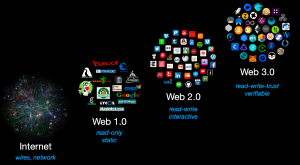Introduction
Imagine opening an app where you own your profile, your posts, and even a slice of the network itself. No single corporation can silence you or sell your data without permission. Instead, rules are written into public code, and every user has a vote. This new model is the promise of web3 social platforms. By blending blockchain, token rewards, and community governance, these networks aim to fix the trust gaps that plague today’s web2 giants. In this guide, we explain how they work, why they matter, and what challenges lie ahead—using clear language so anyone can follow along.
This article explains what Web3 social platforms are, how they work, why they matter, and how they help build new, vibrant communities. Through simple examples and a clear structure, you will learn how Web3 is changing the social media landscape and why you might want to explore these emerging platforms.
What Is Web3 Social Media
Simple Definition
Web3 social media is an online space where user content, identity, and relationships are stored on decentralized networks rather than on private servers. Each post lives on a blockchain or an interlinked peer-to-peer file system. Users log in with cryptographic wallets, not with email and password. The result is a decentralized social media experience that puts power in the hands of its members.
Key Differences From Web2
Web2 platforms such as Facebook hold your data, set the rules, and monetize ads around your content. In web3, data belongs to you. You can port it to another app that uses the same open social graph. Ads may still exist, but you control the revenue split through social tokens or direct payments.
How Web3 Social Platforms Work

Core Technology Layers
- Blockchain ledger: Records content hashes, user reputations, and token balances.
- Decentralized storage: Protocols like IPFS store media files off-chain but still peer-to-peer.
- Smart contracts: Code that handles likes, follows, and tipping without a central database.
- Wallet logins: Wallets serve as both identity and payment rails, securing the system.
Token Design
Most networks issue a native token used for tipping creators, staking for governance, and rewarding valuable contributions. Scarce supply drives engagement and can align incentives between users and developers.
Benefits for Users and Creators
True Content Ownership
Once a post is published, its record stays on-chain under your wallet address. You can export or delete it on your terms.
Direct Monetization
Creators earn through tips, pay-per-view posts, or revenue-sharing pools. No middle layer takes a large cut.
Community Governance
Token holders vote on feature upgrades, moderation guidelines, and treasury spending. This democratic model balances power among many voices.
Challenges and Trade-Offs

Onboarding Complexity
Setting up a wallet and remembering seed phrases confuse newcomers. Until user interfaces simplify, mass adoption faces hurdles.
Scalability Issues
Public blockchains can slow when millions of transactions hit at once. Layer-two networks and sidechains help, yet they add complexity.
Moderation Dilemmas
Free speech ideals clash with the need to curb harmful content. Communities must design transparent rules and enforcement tools.
Popular Web3 Social Platforms in 2025
| Platform | Core Feature | Token Model | User Base (Millions) |
|---|---|---|---|
| Lens Protocol | Open social graph for multiple front ends | Lens Token | 4.2 |
| Farcaster | Wallet-based usernames with portable followers | Frames Credits | 1.9 |
| Friend.tech | Creator gated chats that share fees with leads | Keys | 1.2 |
| Steem 2.0 | Up-and-vote to earn crypto for posts | STEEM | 5.0 |
| Nostr Apps | Simple relay system for posts; no native token | External sats via Lightning | 2.5 |
User counts are community-reported averages for early 2025.
How Communities Form on Web3 Social Apps
Shared Ownership Sparks Loyalty
When members hold tokens, they feel invested. A rising token price or valuable perk drives them to invite friends, moderate spam, and build tools.
Open APIs Enable Niche Front Ends
Developers can fork the base protocol and craft interfaces for gamers, artists, or researchers. Because the underlying social graph is open, followers move seamlessly between apps.
Reputation Layer Encourages Civility
Wallet addresses gain reputation points for positive behavior. Bad actors risk losing points or facing smart-contract timeouts. Unlike centralized bans, these penalties are transparent.
Tips for Joining and Building in Web3 Communities

To make the most of Web3 social platforms, follow these guidelines.
Start with a Trusted Crypto Wallet
Set up a simple, user-friendly wallet that supports NFTs and tokens, such as MetaMask or Rainbow. Practice sending and receiving small amounts of test tokens. Ensuring you understand wallet basics—like seed phrases and safe storage—helps avoid loss and frustration.
Choose Platforms Based on Interests
Look for Web3 social platforms that align with your passions. If you like streaming music, try Audius. For text-based discussions, Lens-powered apps might suit you. By picking platforms relevant to your interests, you find communities where you can contribute and learn.
Earn and Stake Tokens Carefully
Participate in community activities—like posting quality content, curating posts, or helping with moderation—to earn tokens. Staking tokens in governance or rewards pools can boost your influence, but only stake what you can afford to lose. Understand token economics before investing.
Engage and Follow DAO Proposals
Keep track of governance forums or Discord channels where proposals get discussed. Voting on changes is how you shape community rules, features, and development priorities. Regular engagement helps you stay informed about important decisions and makes your voice heard.
Share Resources and Mentor Newcomers
Help others learn by posting guides on wallet setup, token staking, or NFT creation. Sharing educational resources builds goodwill and strengthens communities. As others join, they’ll remember your help and contribute positively in return.
Prioritize Security Practices
- Enable two-factor authentication where possible. Check you’re interacting with official platform sites and not phishing links. Only sign transactions related to platform activities—never approve random token swaps or requests. Regularly update wallets and security software to guard against hacks.
The Creator Economy in Web3
New Revenue Paths
Creators can mint limited edition NFTs, sell backstage passes via token gates, or bundle content with governance perks. Micro-payments flow instantly, cutting out third-party processors.
Fan Participation
Fans who own creator tokens may get voting rights on future content themes or merch designs, turning passive viewers into active partners.
Future Trends
Interoperable Identity
Projects are building universal social IDs that aggregate wallet history, on-chain aliases, and reputation into one portable profile.
Cross-Chain Bridges
Connecting Ethereum, Solana, and other networks will let users post once and share everywhere, widening audience reach.
Privacy Layers
Zero-knowledge proofs allow selective content sharing. You can prove your age or fan-club membership without exposing personal details.
Future Outlook for Web3 Social Platforms

Web3 social platforms will continue to evolve as technology and adoption grow.
Improved User Interfaces
Simplified wallet management and better onboarding tools will lower barriers to entry. Users may connect using social logins that create wallets behind the scenes. Intuitive designs will help non-crypto natives join safely.
Cross-Chain Bridges and Universal Profiles
Advances in cross-chain technology will let you carry your identity and tokens between platforms on different blockchains. Standards like WalletConnect 2.0 or cross-chain identity protocols will make social graphs truly interoperable.
Enhanced Privacy Features
Privacy-focused protocols such as zero-knowledge proofs will let users interact without revealing their full identity or transaction history. Private messaging on Web3 platforms will offer stronger encryption and ephemeral messaging options.
AI-Driven Content Curation
Artificial intelligence will help surface relevant posts, match new participants with communities, and detect harmful content automatically. AI tools will work alongside human moderators to keep environments safe and welcoming.
Mainstream Adoption and Corporate Integration
Large tech companies may partner with Web3 protocols to integrate decentralized social features into existing apps. For example, a music streaming service might add a Lens-powered social layer for listeners to share tracks. This hybrid approach will introduce millions of users to Web3 communities gradually.
Conclusion
Web3 social platforms promise a shift from corporate-owned networks to user-owned communities. They blend blockchain transparency, token incentives, and open-source code to create spaces where people build, earn, and govern together. While hurdles like onboarding and moderation remain, early adopters already see tighter bonds and fairer rewards. As technology matures, these networks may redefine how we gather online, giving every user a piece of the digital towns they inhabit.











